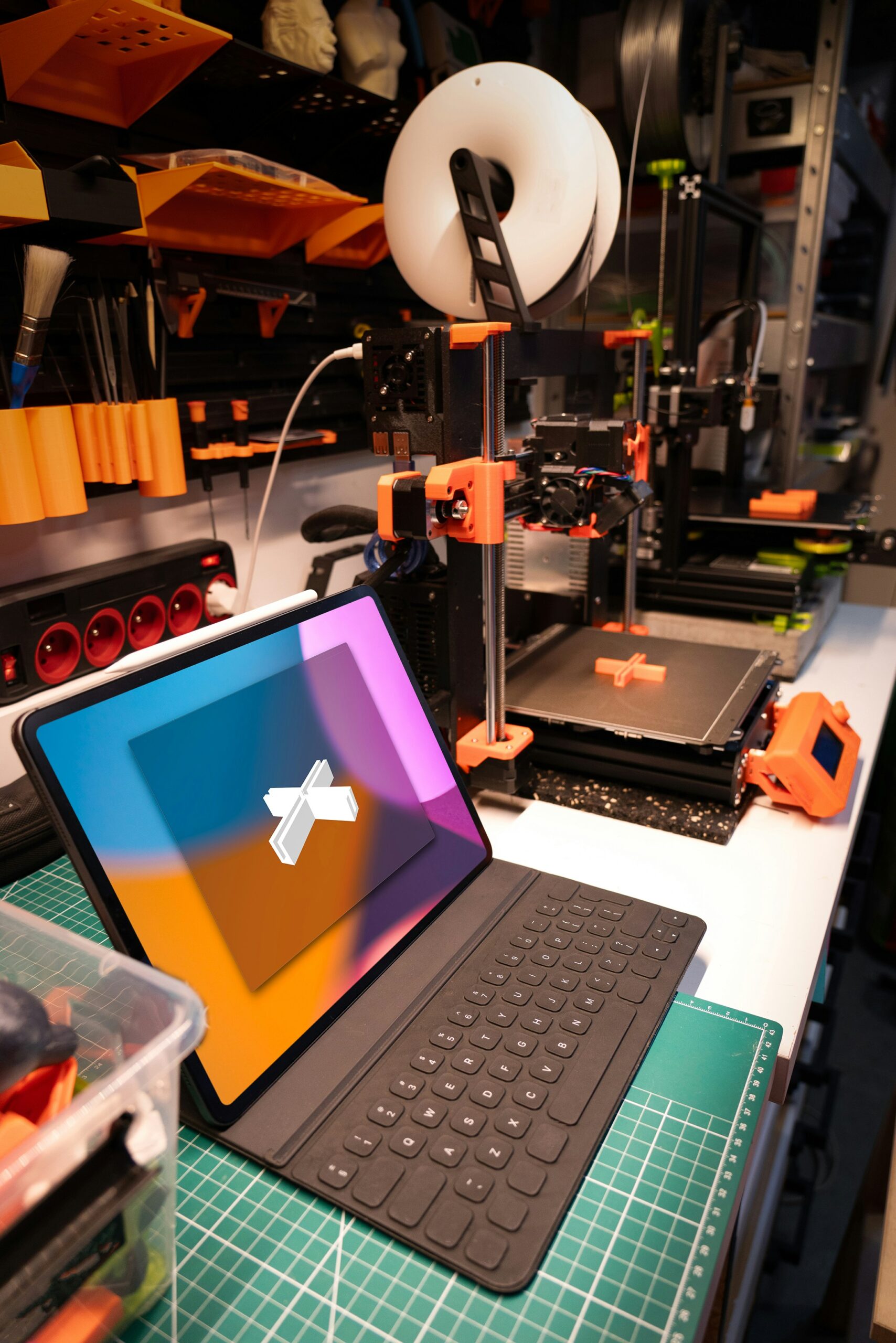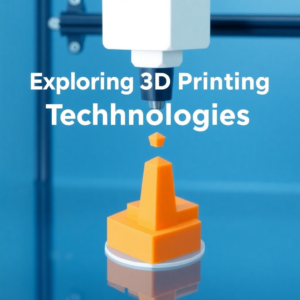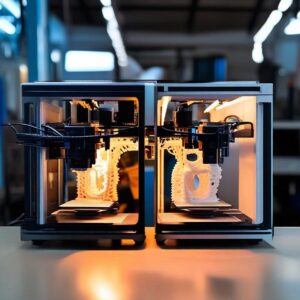3D Printing Slicing Software: Guide to Cura, Slic3r, and Simplify3D

Unlock the full potential of 3D printing with our comprehensive guide to Cura, Slic3r, and Simplify3D slicing software. Dive deep into their features, advantages, and use cases to determine which tool best fits your 3D printing requirements and takes your projects to the next level.
Cura, Slic3r, and Simplify3D
Slicing software is a critical component of 3D printing that ensures your designs are realized with precision and efficiency. After creating a 3D model, slicing software converts the design into G-code , a set of instructions your 3D printer understands. These instructions determine everything from layer heights to print speeds and support structures, directly impacting the quality of your final print. The right slicing software can make a huge difference in maximizing your printer’s capabilities while simplifying the setup for every project.
Among the many slicing software options available, Cura , Slic3r , and Simplify3D are three of the most popular and reliable tools on the market. Each caters to a specific segment of users, ranging from beginners who value ease of use to professionals requiring advanced control over their output. Cura, developed by Ultimaker, is open-source and widely regarded as one of the most accessible and versatile options for hobbyists and professionals alike. Slic3r is also open-source and stands out for its wide customization options and innovative features, including multi-material printing. Simplify3D, on the other hand, is a premium product that offers optimized performance, advanced support systems, and excellent multi-printer management, making it best suited for professionals and commercial applications.
This guide explores these three slicing software solutions, diving into their features, pros, cons, and ideal audiences. Whether you’re just starting your 3D printing journey or are a seasoned expert, this detailed comparison will help you select the ideal slicing software for your workflow.
Comparison Table: Cura, Slic3r, and Simplify3D
Cura: The Free and Versatile Favorite
Cura, developed by Ultimaker, is one of the most recognized names in the world of slicing software. Its open-source model and regular community-driven updates make it accessible for both beginners and advanced users. By simplifying complex 3D printing workflows and offering comprehensive features at no cost, Cura has become the go-to slicing tool for hobbyists and small-scale users. Furthermore, Ultimaker consistently improves Cura’s ecosystem, ensuring compatibility with various 3D printers, including non-Ultimaker brands like Creality, Anycubic, and Prusa.
One of the most prominent advantages of Cura is its user-friendly interface, which guides new users step by step through the slicing workflow. The software allows users to adjust basic settings such as filament type, print speed, or infill density, and users can fine-tune their prints through Cura’s 400+ advanced settings. Beginners can rely on pre-configured profiles for popular printers and materials, while experts have the freedom to customize their projects in exceptional detail. Cura’s versatility caters to users of all skill levels.
Cura also boasts a robust plugin marketplace , which enhances its functionality. These plugins allow for integrations with CAD software and other specialized features, such as material profiles for uncommon filaments. Additionally, Cura’s preview function offers an intuitive way to inspect sliced models, breaking the print down layer by layer to check the tool paths and diagnose potential issues before printing. This feature is especially helpful for avoiding failed prints or wasting expensive materials.
Another reason Cura is so widely favored is its cost—it’s completely free. Accessibility can be a major factor for first-time users, making Cura an ideal entry point for those new to 3D printing. Moreover, it’s continually updated by developers and a vibrant community of users, which keeps the tool ahead of the curve in terms of technology and flexibility.
However, Cura does have limitations. Its extensive settings can overwhelm true beginners, who may not yet understand the significance of individual parameters. Additionally, large or complex models can be computationally demanding, slowing down older PCs or laptops. Despite these challenges, Cura remains the best choice for hobbyists and budget-conscious users who need reliable, intuitive slicing software.
Cura is the perfect slicing software for hobbyists, students, and small-scale 3D printing enthusiasts looking for versatility and cost efficiency. Its expanding ecosystem, robust community support, and compatibility with third-party printers make it an invaluable tool for evolving workflows.
Slic3r: The Open-Source Power Tool
Slic3r is another open-source slicing software that’s known for its powerful customization capabilities and innovative design features. This software is particularly popular among advanced users who prefer having granular control over their settings. Like Cura, Slic3r is free to use and benefits from a strong developer community that regularly contributes to its growth and evolution. Its modular interface offers unparalleled flexibility to accommodate a variety of printer setups and printing styles.
What sets Slic3r apart is its emphasis on customization. Users can tweak nearly every aspect of their print, from infill patterns and material flow to temperature settings and cooling strategies. Slic3r even allows users to create unique, functional infill patterns such as gyroid, honeycomb, or 3D grid designs. This not only enhances a print’s structural integrity but also reduces material usage, saving time and resources. For multi-material printers, Slic3r offers advanced support for dual and multi-extrusion workflows , enabling the production of complex, multicolor, or multifunctional prints.
Unlike Cura, Slic3r doesn’t prioritize simplicity, which can make it a daunting tool for those just starting with 3D printing. Its user interface, while functional, lacks the polish and accessibility of more streamlined software like Cura. That said, advanced users and professionals value the sheer depth of control Slic3r offers, as it gives them the ability to fine-tune every detail of their print for optimized performance.
Another advantage of using Slic3r is its resource efficiency—it’s lightweight and runs well even on modest hardware setups, making it ideal for users who don’t have access to high-powered computers. Moreover, Slic3r is the foundation for other popular slicing software like PrusaSlicer , further solidifying its reputation as a dependable tool.
However, Slic3r is not without its challenges. Beginners may face difficulties navigating the software due to its complexity and lack of built-in guided tutorials. Additionally, troubleshooting Slic3r can sometimes be tricky, as its user base, while active, is not as extensive as Cura’s. Yet for those willing to invest time in learning its nuances, Slic3r offers unrivaled precision and flexibility.
Slic3r is best suited for intermediate to advanced users, experimental tinkers, and professionals seeking advanced slicing capabilities without incurring costs. Its flexibility is perfect for multi-material workflows, experimenting with infill designs, or optimizing resource use.
Simplify3D: Professional-Grade Flexibility
Simplify3D is widely regarded as top-tier slicing software for professional users and businesses. Unlike Cura and Slic3r, Simplify3D is not free—it requires users to purchase a license. However, its powerful and reliable features make it a worthwhile investment for those who prioritize exceptional quality and time-saving performance. From advanced support customization to seamless multi-printer profiles, Simplify3D is tailored to professionals needing consistent results for intricate projects.
One of Simplify3D’s biggest strengths is its support structure generation. Users can manually create or edit support locations, optimizing material use and minimizing post-processing. These manually positioned supports significantly reduce the risk of damaging overhanging or intricate prints, which is a game-changer for complex geometries. Additionally, Simplify3D’s slicing engine is fast and efficient, often processing large models much quicker than its competitors.
Simplify3D also offers multi-printer management , allowing users to manage multiple printers, profiles, and workflows in a single environment. This capability is ideal for small businesses or print farms handling large batches of designs. Beyond that, the software boasts pre-print simulations, ensuring users can visualize the entire layer-by-layer process to spot potential errors ahead of time. Combined with precise calibration for virtually every printer setting, these features position Simplify3D as a reliable solution for professional-grade printing.
Despite its strengths, Simplify3D is not without drawbacks. The cost —currently priced around $149 per license—is a significant factor, especially for hobbyists or casual users who can achieve satisfactory results using free alternatives. Simplify3D also lacks a free trial, leaving users to purchase it upfront without testing. Moreover, its updates are less frequent compared to open-source counterparts like Cura, which benefit from large developer communities.
Simplify3D is ideal for professional designers, engineers, and 3D printing businesses where time efficiency, precise control, and consistent results are non-negotiable. Its robust slicing tools and superior capability to customize support structures make it well worth the investment for advanced users.
The choice of slicing software can greatly influence the quality and efficiency of your 3D printing workflow. Cura remains the best free option for beginners and hobbyists, offering an unbeatable combination of usability and versatility. Slic3r caters to advanced tinkerers and experimental users with its highly customizable settings, making it ideal for multi-material printing and unique infill designs. Finally, Simplify3D is a professional’s dream, delivering fast, efficient slicing, advanced features, and support customization for consistent, top-quality results.
Whether you’re a beginner testing out your first printer or a professional managing a print farm, Cura, Slic3r, and Simplify3D each bring unique strengths to the table. Evaluating your needs and goals will guide you toward the slicing software best suited for your projects.
FAQs
1. What is slicing software, and why is it important?
Answer:
Slicing software converts 3D models into G-code , which serves as instructions for 3D printers to build objects layer by layer. It determines essential parameters like print speed, temperature, infill, supports, and resolution. Without slicing software, your 3D printer cannot interpret and print digital models.
2. Which slicing software is best for beginners?
Answer:
Cura is the best option for beginners due to its user-friendly interface, pre-configured profiles for popular printers and materials, and its completely free, open-source model. It’s perfect for newcomers who want to start 3D printing without worrying about costs or steep learning curves.
3. How does Slic3r differ from Cura?
Answer:
Slic3r is specifically geared toward advanced users who require granular control over slicing parameters. It offers unique features like customizable infill patterns and multi-material support for more complex printing setups. Cura, while robust, is more beginner-friendly and comes with a wider range of pre-configured settings.
4. Why is Simplify3D considered “premium” slicing software?
Answer:
Simplify3D is a paid tool known for its professional-grade features. It excels in creating editable support structures, optimizing multi-printer workflows, and providing high-performance slicing throughput. Its efficiency in handling intricate or large designs makes it the go-to choice for professionals and businesses.
5. Can beginners use Simplify3D?
Answer:
While Simplify3D is designed with professionals in mind, its interface is intuitive enough for beginners to learn quickly. However, its upfront cost may deter casual users, especially since free alternatives like Cura offer sufficient functionalities for most entry-level needs.
6. Does Slic3r support multi-material printers?
Answer:
Yes, Slic3r offers multi-material and multi-extrusion support , allowing users to create prints that combine different filament types or colors. This makes it a great choice for users who require additional flexibility for more complex projects.
7. Can these slicing software programs work with any 3D printer?
Answer:
- Cura : Works with most popular 3D printers, including Creality, Anycubic, and Prusa models.
- Slic3r : Compatible with a wide range of open-source and commercial 3D printers, especially those that allow parameter customization.
- Simplify3D : Supports nearly all 3D printers on the market due to its comprehensive set of printer profiles.
8. Is Slic3r or Cura better for complex designs?
Answer:
Slic3r is generally better for highly complex prints requiring advanced customization, such as functional infill patterns or multi-material setups. However, Cura can also handle complex designs effectively with its wide range of adjustable settings and plugins—the choice depends on workflow preferences and experience levels.
9. What are the system requirements for each software?
Answer:
- Cura : Compatible with both Windows and macOS but requires more processing power for large or intricate models.
- Slic3r : Lightweight and can run on older computers, making it resource-efficient.
- Simplify3D : Requires higher hardware performance for best results, as it’s built for complex and detailed models.
10. Which slicing software is best for commercial use?
Answer:
Simplify3D is the best choice for commercial use because of its speed, precision, and multi-printer management capabilities. Its paid nature makes it more reliable for professional-grade projects, particularly for print farms or businesses requiring consistent, high-quality output.
If you’d like to learn more or download the tools discussed, visit the Cura website , the Slic3r webpage , or the Simplify3D official site for detailed resources, tutorials, and setup guides.
If you found this helpful, please stay tuned to our blogs!!





